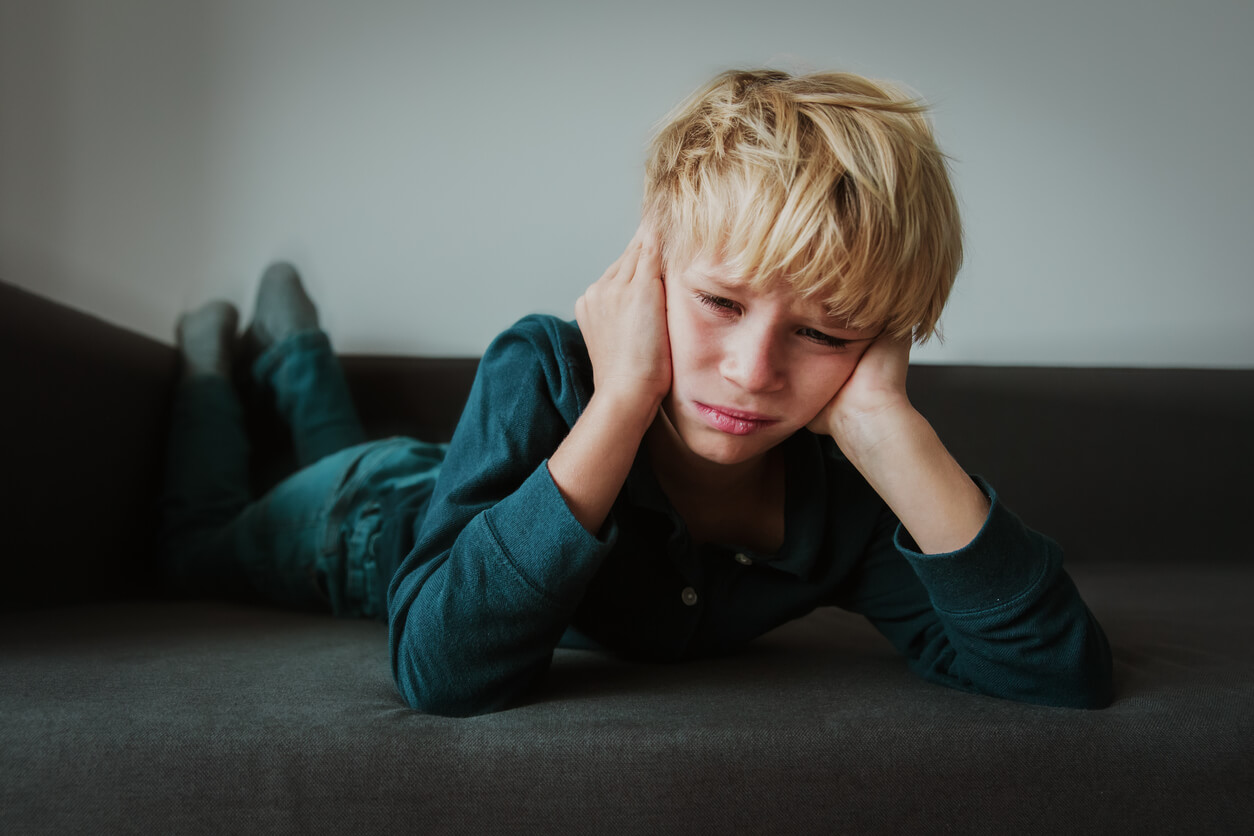The Emotional Impact of Trauma on Children


Written and verified by the psychologist Elena Sanz Martín
Experiencing a traumatic event is extremely hard for anyone, but it’s even harder for children. They don’t yet have as many management resources as adults. As they’re vulnerable and dependent, the impact can be greater and more long-lasting for them. The impact of trauma on children shakes the sense of security and well-being in their lives, so they’ll need support to overcome it.
Childhood is a time when we need to feel loved, safe, and protected. It’s during these years that our trust in others and in life is forged, and suffering a major setback can tear down all these foundations. As a result, insecurity, fear, and anxiety can settle in the child’s life and it’s possible for their reactions and behaviors to not be the most appropriate, as they’ll arise based on that event that changed everything.
What is trauma in children?
When we talk about trauma, we refer to an event that was experienced with great fear or anguish because we felt that it could threaten our physical or psychological integrity. In other words, it’s a negative experience that’s experienced with great intensity, is perceived as very threatening, and in the face of which we feel that we don’t have the necessary resources to cope.
Therefore, we can talk about natural catastrophes, attacks, accidents, or abuses experienced; but also about apparently less dramatic situations. Trauma isn’t characterized so much by the event itself, but by the way in which the person experiences it. For example, a child who has suffered parental neglect, who has witnessed fights in the family environment, or who has suffered separations from their main figures may experience this as a trauma.
The severity of the emotional impact will depend on several factors. Among them are the age of the child, their own personality, and the coping resources available to them. But we also know that the impact is greater when the negative situation is repeated, is continuous, or when the child doesn’t have a social support network.

The emotional impact of trauma on children
Trauma impacts children in many different ways. When such a threatening and negative situation is experienced, the brain makes sure that the memory isn’t forgotten and the strong fight-flight response that was triggered at the beginning may remain later on. Thus, these are some of the main sequelae that the child may experience:
Constant alertness
Hypervigilance appears, a tendency to be constantly on alert and aware of the environment. They do this in order to prevent future negative situations. The child seems unable to be calm and pays attention to every external stimulus with anxiety.
A need for control
Control gives us a sense of tranquility, and at this time is when children most need to feel that their world is predictable. Because of this, they may have difficulty coping with change and react extremely when it occurs.
Inappropriate responses
Certain situations or stimuli may trigger inappropriate responses. There are certain places, people, sounds, smells, or sensations that are reminiscent of the trauma and, when they appear, trigger those panic and defense reactions again. Children usually try to avoid these triggers but may react with tantrums or aggression if they occur.
Difficulty in managing emotions
There’s great difficulty in managing overwhelming emotions. Great sadness and apathy may appear, or emotional blocking, that is, the child may feel emotionally paralyzed. Also, they may tend to isolate themselves.

Having nightmares
It’s very common for the child to re-experience or relive the event through flashbacks, nightmares, mental images, or memories that are very distressing.
Disorganized attachment
If the trauma is experienced with the primary caregivers, the infant or child is likely to develop disorganized attachment. As a result, they’ll have difficulty trusting themselves and others, which will affect their well-being and relationships.
Treatment and intervention
The impact of trauma on children usually triggers acute stress disorder. This is a condition that includes the above symptoms, appears immediately after the event, and lasts from three days to one month. In other cases, post-traumatic stress disorder may emerge.
When a child experiences trauma, they’ll need adult support to overcome this experience and its aftermath. The best thing you can do for them is to offer them stability and predictability, with routines that are respected and affection that’s always available. Allowing them to choose certain aspects of their daily life (for example, deciding what to eat or how to dress) will also give them a sense of control that they need.
But, above all, it’s important to be patient and work on emotional expression. The child needs to learn ways to express and channel what they feel. For all this, seeking professional help is extremely important in order to keep the impact of the trauma from becoming prolonged.
Experiencing a traumatic event is extremely hard for anyone, but it’s even harder for children. They don’t yet have as many management resources as adults. As they’re vulnerable and dependent, the impact can be greater and more long-lasting for them. The impact of trauma on children shakes the sense of security and well-being in their lives, so they’ll need support to overcome it.
Childhood is a time when we need to feel loved, safe, and protected. It’s during these years that our trust in others and in life is forged, and suffering a major setback can tear down all these foundations. As a result, insecurity, fear, and anxiety can settle in the child’s life and it’s possible for their reactions and behaviors to not be the most appropriate, as they’ll arise based on that event that changed everything.
What is trauma in children?
When we talk about trauma, we refer to an event that was experienced with great fear or anguish because we felt that it could threaten our physical or psychological integrity. In other words, it’s a negative experience that’s experienced with great intensity, is perceived as very threatening, and in the face of which we feel that we don’t have the necessary resources to cope.
Therefore, we can talk about natural catastrophes, attacks, accidents, or abuses experienced; but also about apparently less dramatic situations. Trauma isn’t characterized so much by the event itself, but by the way in which the person experiences it. For example, a child who has suffered parental neglect, who has witnessed fights in the family environment, or who has suffered separations from their main figures may experience this as a trauma.
The severity of the emotional impact will depend on several factors. Among them are the age of the child, their own personality, and the coping resources available to them. But we also know that the impact is greater when the negative situation is repeated, is continuous, or when the child doesn’t have a social support network.

The emotional impact of trauma on children
Trauma impacts children in many different ways. When such a threatening and negative situation is experienced, the brain makes sure that the memory isn’t forgotten and the strong fight-flight response that was triggered at the beginning may remain later on. Thus, these are some of the main sequelae that the child may experience:
Constant alertness
Hypervigilance appears, a tendency to be constantly on alert and aware of the environment. They do this in order to prevent future negative situations. The child seems unable to be calm and pays attention to every external stimulus with anxiety.
A need for control
Control gives us a sense of tranquility, and at this time is when children most need to feel that their world is predictable. Because of this, they may have difficulty coping with change and react extremely when it occurs.
Inappropriate responses
Certain situations or stimuli may trigger inappropriate responses. There are certain places, people, sounds, smells, or sensations that are reminiscent of the trauma and, when they appear, trigger those panic and defense reactions again. Children usually try to avoid these triggers but may react with tantrums or aggression if they occur.
Difficulty in managing emotions
There’s great difficulty in managing overwhelming emotions. Great sadness and apathy may appear, or emotional blocking, that is, the child may feel emotionally paralyzed. Also, they may tend to isolate themselves.

Having nightmares
It’s very common for the child to re-experience or relive the event through flashbacks, nightmares, mental images, or memories that are very distressing.
Disorganized attachment
If the trauma is experienced with the primary caregivers, the infant or child is likely to develop disorganized attachment. As a result, they’ll have difficulty trusting themselves and others, which will affect their well-being and relationships.
Treatment and intervention
The impact of trauma on children usually triggers acute stress disorder. This is a condition that includes the above symptoms, appears immediately after the event, and lasts from three days to one month. In other cases, post-traumatic stress disorder may emerge.
When a child experiences trauma, they’ll need adult support to overcome this experience and its aftermath. The best thing you can do for them is to offer them stability and predictability, with routines that are respected and affection that’s always available. Allowing them to choose certain aspects of their daily life (for example, deciding what to eat or how to dress) will also give them a sense of control that they need.
But, above all, it’s important to be patient and work on emotional expression. The child needs to learn ways to express and channel what they feel. For all this, seeking professional help is extremely important in order to keep the impact of the trauma from becoming prolonged.
All cited sources were thoroughly reviewed by our team to ensure their quality, reliability, currency, and validity. The bibliography of this article was considered reliable and of academic or scientific accuracy.
- Healthy Children. (2020). La crianza después de un trauma: cómo atender a las necesidades de su niño. HealthyChildren.org. https://www.healthychildren.org/Spanish/family-life/family-dynamics/adoption-and-foster-care/Paginas/Parenting-Foster-Adoptive-Children-After-Trauma.aspx#:%7E:text=Los%20ni%C3%B1os%20que%20han%20sido,de%20una%20actividad%20a%20otra.
- Elia, J. (2022, 8 agosto). Trastornos de estrés agudo y postraumático en niños y adolescentes. Manual MSD versión para público general. https://www.msdmanuals.com/es-es/hogar/salud-infantil/trastornos-de-la-salud-mental-en-ni%C3%B1os-y-adolescentes/trastornos-de-estr%C3%A9s-agudo-y-postraum%C3%A1tico-en-ni%C3%B1os-y-adolescentes
This text is provided for informational purposes only and does not replace consultation with a professional. If in doubt, consult your specialist.








